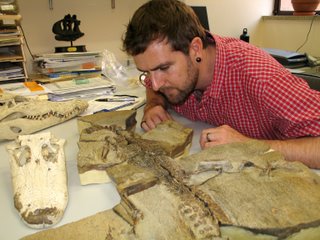Ancient croc proves life begins in Isisford

AFTER nearly seven years, the Isisford Shire has finally been able to announce that the most primitive crocodilian fossils ever to be unearthed were discovered in their own backyard.
When former Isisford deputy mayor Ian Duncan stumbled across the fossilised remains in the mid-1990s, in a dry creek bed on the outskirts of town, little did he know it would set off a chain reaction of scientific events.
What Mr Duncan had found was an incomplete skeleton of Isisfordia duncani – the most primitive crocodilian species found on Earth – busting the myth that modern species of crocodile evolved in the northern hemisphere.
It would take University of Queensland palaeontologists another four years of scratching around the Isisford Shire before they would find the Holy Grail of crocodilian species: the complete remains of Isisfordia, including a previously missing head specimen.
Isisford Shire chief executive officer Rob Bauer explained that while it was difficult to keep the find under wraps, it was for the benefit of the community.
"There are two ways to deal with a bone – you can either announce it to the world without exactly knowing what it is or you can leave it to the professionals to determine what the specimen is.
"In order to do the latter, it takes time.
"The University of Queensland experts had to put together a thesis, and then seek comment on their work from other professionals in their field from around the world.
"The next step was to get their work published in a report. Then, and only then, could they put a name to it.
"It was pretty hot gossip around town and while a lot of people knew that something had been found, they didn’t know what it was or the significance of the find.
"The most common comment around town is: ‘This usually happens in other places’."
While the experts were busy finding fossils and publishing reports, the people of Isisford were left with the question: Where to house all these world-first fossils?
"We have gone through a process of our own, building the Interpretation Centre to house a replica of the find.
"A lot of exhibits across the country are man-made, but we wanted to have the whole centre revolve around nature – evolution, the Great Artesian Basin, fossils and the environment around us today.
"While the centre won’t cure all of Isisford’s problems, it will hopefully put us on the map and tourists will have an influence on the lives of the people who live here."
The new animal was described in the prestigious Proceedings of the Royal Society journal on June 14 by an international team of palaeontologists, led by UQ’s Doctor Steve Salisbury.
"These are the most complete crocodilian fossils yet discovered in Australia, providing us with valuable new insights into the early evolution of today’s crocodilians and their lifestyle as semi-aquatic ambush predators," Dr Salisbury said.
"Living 98 to 95 million years ago, Isisfordia predates the first recorded appearance of alligators and gharials by almost 20 million years, and the first true crocodiles by over 30 million years.
"Adults appear to have been just over one metre in length, and probably weighed no more than three kilograms.
"It may have been small by today’s standards, but it represents a very important phase in the evolutionary history of crocodilians."
Isisfordia duncani will be housed at the University of Queensland, while the Governor of Queensland, Ms Quentin Bryce, will unveil a replica at the Outer Barcoo Interpretation Centre opening on July 14.

0 Comments:
Post a Comment
<< Home